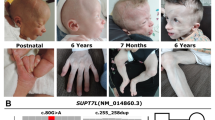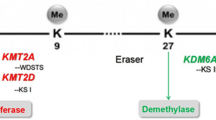Abstract
Prader–Willi syndrome (PWS) is a neurobehavioral disorder caused by the lack of paternal expression of imprinted genes in the human chromosome region 15q11–13. Recent studies of rare human translocation patients narrowed the PWS critical genes to a 121-kb region containing PWCR1/HBII-85 and HBII-438 snoRNA genes. The existing mouse models of PWS that lack the expression of multiple genes, including Snrpn, Ube3a, and many intronic snoRNA genes, are characterized by 80%–100% neonatal lethality. To define the candidate region for PWS-like phenotypes in mice, we analyzed the expression of several genetic elements in mice carrying the large radiation-induced p30PUb deletion that includes the p locus. Mice having inherited this deletion from either parent develop normally into adulthood. By Northern blot and RT-PCR assays of brain tissue, we found that Pwcr1/MBII-85 snoRNAs are expressed normally, while MBII-52 snoRNAs are not expressed when the deletion is paternally inherited. Mapping of the distal deletion breakpoint indicated that the p30PUb deletion includes the entire MBII-52 snoRNA gene cluster and three previously unmapped EST sequences. The lack of expression of these elements in mice with a paternal p30PUb deletion indicates that they are not critical for the neonatal lethality observed in PWS mouse models. In addition, we identified MBII-436, the mouse homolog of the HBII-436 snoRNA, confirmed its imprinting status, and mapped it outside of the p30PUb deletion. Taking together all available data, we conclude that the lack of Pwcr1/MBII-85 snoRNA expression is the most likely cause for the neonatal lethality in PWS model mice.



Similar content being viewed by others
References
Bachellerie JP, Cavaille J, Huttenhofer A (2002) The expanding snoRNA world. Biochimie 84: 775–790
Cavaille J, Buiting K, Kiefmann M, Lalande M, Brannan CI, et al. (2000) Identification of brain-specific and imprinted small nucleloar RNA gnes exhibiting an unusual genomic organization. Proc Natl Acad Sci USA 97: 14311–14316
de los Santos T, Schweizer J, Rees CA, Francke U (2000) small evolutionarily conserved RNA, resembling C/D box small nuceolar RNA, is transcribed from PWCRI, a novel imprinted gene in the Prader–Willi deletion region, which highly expressed in brain, Am J Hum Genet 67: 1067–1082
Dhar MS, Johnson DK (1997) A microsatellite map of the pink-eyed dilution (p) deletion complex in mouse chromosome 7. Mamm Genome 8: 143–145
Dhar M, Webb LS, Smith L, Hauser L Johnson D, West DB (2000) A novel ATPase on mouse chromosome 7 is a candidate gene for increased body fat. Physiol Genomics 4: 93–100
Dhar MS, Sommardahl CS, Kirkland T, Nelson S, Donnell R, et al. (2004) Mice heterozygous for Atp10c, a putative amphipath, represent a novel model of obesity and type 2 diabetes. J Nutr 134 799–805
Gabriel JM, Merchant M Ohta T, Ji Y, Caldwell RTG, et al. (1999) A transgene insertion creating a heritable chromosome deletion mouse model of Prader–Willi and Angelman syndromes. Proc Natl Acad Sci U S A 96: 9258–9263
Gallagher RC, Pils B, Albalwi M, Francke U (2002) Evidence for the role of PWCR1/HBII-85 C/D box small nucleolar RNAs in Prader–Willi syndrome. Am J Hum Genet 71: 669–678
Johnson DK, Stubbs LJ, Culiat CT, Montgomery CS Russell LB, et al. M (1995) Molecular analysis of 36 mutations at the mouse pink-eyed dilution (p) locus. Genetics 141: 1563–1571
Levings PP, Bungert J (2002) The human beta-globin locus control region. Eur J Biochem 269: 1589–1599
Nicholls RD, Knepper JL (2001) Genome organization, function, and imprinting in Prader–Willi and Angelman syndromes. Annu Rev Genomics Hum Genet 2: 153–175
Runte M, Huttenhofer A, Gross S, Kiefmann M, Horsthemke B. et al. (2001) The IC-SNURF-SNRPN transcript serves as a host for multiple small nucleolar RNA species and as an antisense RNA for UBE3A. Hum Mol Genet 10: 2687–2700
Runte M, Varon R, Horn D, Horstherake B, Buiting K (2005) Exclusion of the C/D box snoRNA gene cluster HBII-52 from a major role in Prader–Willi syndrome. Hum Genet 116: 228–300
Russell LB, Montgomery CS, Cacherio NL, Johnson DK (1995) Complementation analyses for 45 mutations encompassing the pink-eyed dilution (p) locus of the mouse. Genetics 141: 1547–1562
Schüle B, Albalwi M, Northrop E, Francis DI, Rowell M, et al. Molecular breakpoint cloning and gene expression studies of a novel translocation t(4;15) (q27;q11.2) associated with Prader-Willi Syndrome. BMC Medical Genetics6, 18
Tsai TF, Jiang YH, Bressler J, Armstrong D, Beaudety AL (1999) Paternal deletion from Snrpn to Ube3a in the mouse causes hypotonia, growth retardation and partial lethality and provides evidence for a gene contributing to Prader–Willi syndrome. Hum Mol Genet 8: 1357–1364
Yang T, Adamson TE, Resnick JL, Leff S, Wevrick R, et al. (1998) A mouse model for Prader–Willi syndrome imprinting-centre mutations. Nat Gene19: 25–31
Acknowledgments
The authors thank Art Beaudet, Baylor College of Medicine, for the Snrpn–Ube3a deletion mouse strain, and the members of the Francke lab for generous help and discussion. This work was supported by NIH grant R01 HD 41623 (U.F.), by a Charles E. Culpeper Biomedical Pilot Initiative grant from the Rockefeller Brothers Fund (U.F), and by a grant from the Foundation for Prader–Willi Research (U.F.).
Author information
Authors and Affiliations
Corresponding author
Rights and permissions
About this article
Cite this article
Ding, F., Prints, Y., Dhar, M.S. et al. Lack of Pwcr1/MBII-85 snoRNA is critical for neonatal lethality in Prader–Willi syndrome mouse models. Mamm Genome 16, 424–431 (2005). https://doi.org/10.1007/s00335-005-2460-2
Received:
Accepted:
Issue Date:
DOI: https://doi.org/10.1007/s00335-005-2460-2




